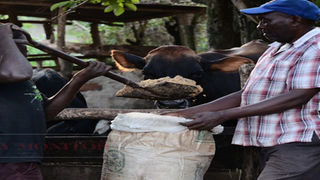
Mugerwa covers silage with a polythene bag. He says that if properly sealed, fermentation of silage is effective in drums. PHOTO/GEARGE KATONGOLE
|Bagging silage a better option for smallholder farmers
What you need to know:
- Most farmers keep silage in piles, trenches or heaps which are costly to smallholder farmers. Y
- et with climate change, it is a matter of time that all farmers embrace silage as an alternative source of feed during the tough dry periods. James Mugerwa, a mixed urban farmer in Mukono has simplified the storage of silage and shares his ideas.
James Mugerwa, a mixed farmer in Mukono explains that protecting animal feed quality is an important aspect of grain feed stocks. Mugerwa says that to minimise spoilage, smallholder farmers can bag their silage.
He says that bagging is the better option if it is done right. He explains that right storage means cutting the silage at the right moisture, packing well, and covering immediately with proper feed out methods that prevent air penetration.
ALSO READ: Animal feeds: How to make hay, silage
To cut silage, experts advise farmers to use more efficient power tools such as the silage chopper machine instead of machetes. Dr Laban Buye, a livestock scientist at Buginyanya Zonal Agricultural Research and Development Institute (BugiZARDI) says that silage choppers can be obtained at Shs2m from local fabricators. “Having good chop quality is important for the animals in terms of palatability. I would advise farmers to form groups of about 10 farmers and share the financial burden of acquiring such farm tools,” Dr Buye says.
Effective
Mugerwa, a retired extension worker explains that when stored in bags, silage losses are about 8-10 percent. He says that bagged silage limits surface spoilage and manageable feed out rates. “Many farmers complain of losses in piles or bunkers saying it is not worth it. However, if they use bags, it is worth trying,” he says.
ALSO READ: Feeding cattle on hay in the dry season
Mugerwa recommends the use of polypropylene sugar bags or plastic drums as an option. Sugar bags are available from retail shops and can be bought at Shs2,000 while blue plastic drums ranging from 30 to 220 litres can be bought from about Shs70,000.
Mugerwa explains that most farmers do not have enough space and labour to dig a bunker, for instance. Yet even when it is time to feed the animals, silage stored in a bunker has high spoilage. He says that since some part of the silage is eaten by microbes, the top black material has a negative feeding value.
“Most times, about five inches of silage needs to be removed from the surface every day even with proper removal of keeping the face tight,” he says. Using bags or drums, Mugerwa says that it is a low investment option. At his farm, he uses domestic workers and children to bag the silage.
Process
Silage material such as legumes and chopped grass should be compacted manually and the drums sealed properly with an air tight cover. The mixture, he advises, should be added with maize bran. Maize bran is an additive used to stimulate fermentation. The materials should then be stored in a cool area and the farmer waits for fermentation to set in.
ALSO READ: How to make molasses for your livestock
After three months, the silage has a light colour and a sweet fermented aroma ready for feeding the animals. With drums, Mugerwa says, feed out losses are significantly reduced.
Caution
But he cautions farmers that while it does not take some skill to pack the bag, they should look for holes for any air exposure. “Even when well packaged, the farmers should regularly check to ensure that holes are patches to keep spoilage to a minimum,” he says.
Mugerwa adds that bags normally take 50kg or slightly more, which makes them unsuitable for farmers with big herds.
Key fact
Silage is forage such as pastures, cereals or legumes cut at high moisture content (typically 40–70 per cent) and stored in an oxygen free environment.




